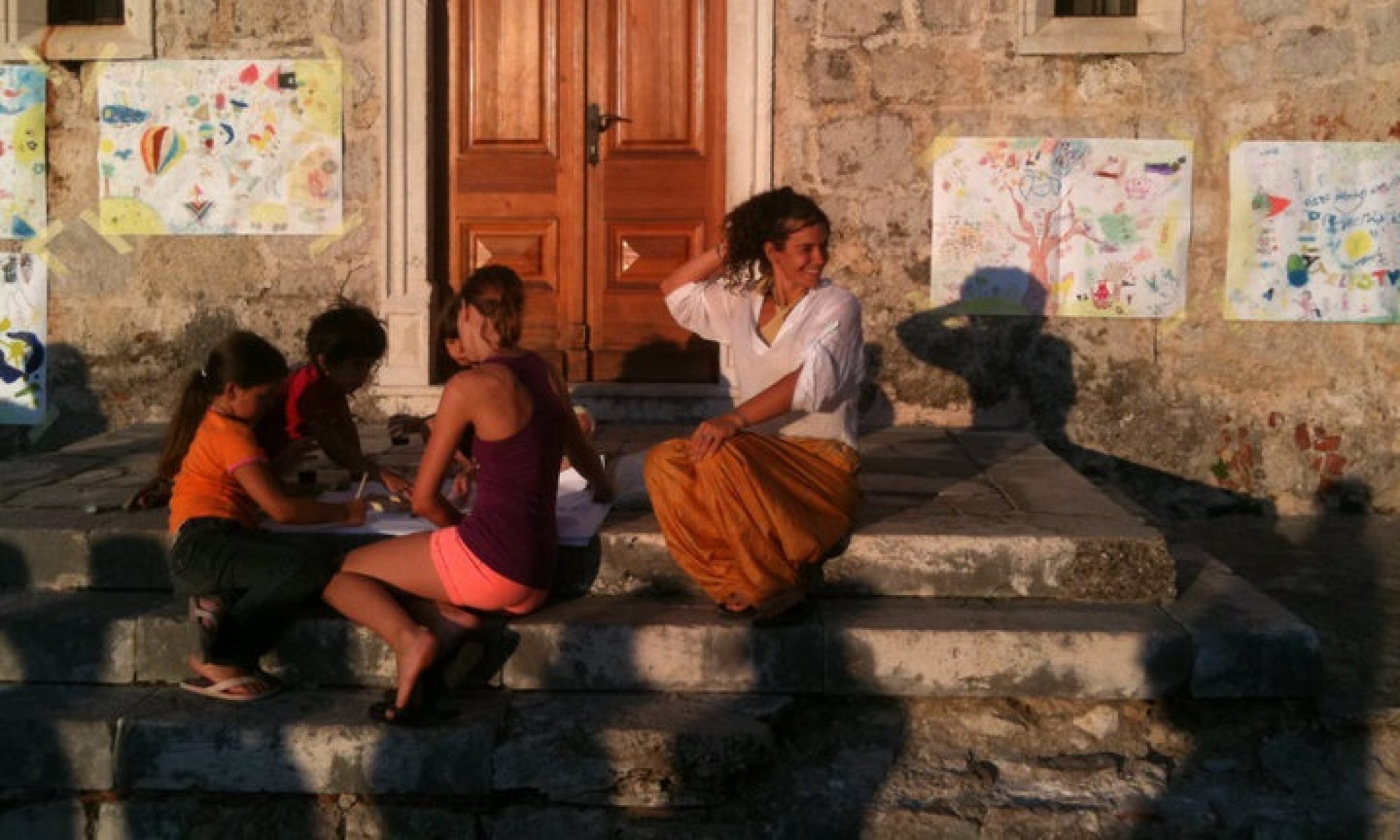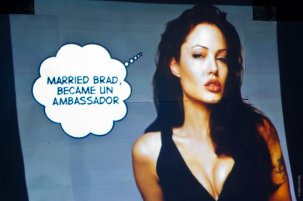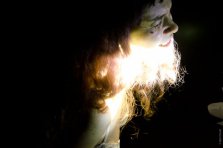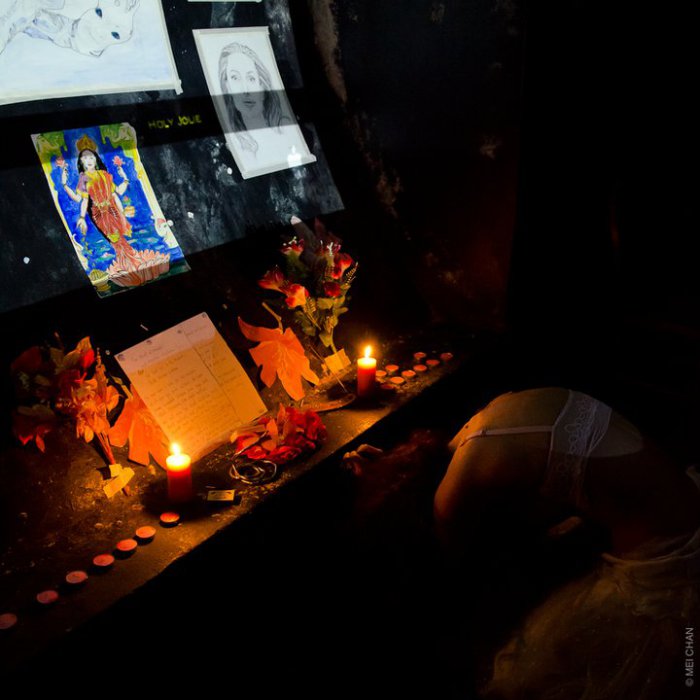Holy Jolie was a twenty-minute long, solo performance that was first performed in April 2011 in Vogue Fabrics, a nightclub in the East End of London. It was shown as part of I’m with You events and Fringe! Queer Film and Arts Festival. Holy Jolie dealt explicitly with the trauma experienced by Bosnian women during and following the mass rape perpetuated by Serbian paramilitary forces during the 1990s war, and the problems of cinematic representation of that trauma by Angelina Jolie as a celebrity with enormous power and influence to shape the story and reach mass audiences.
Figure 3 Image still from Holy Jolie film projection
The performance was devised in two parts – the first part was a ten-minute film projection and the second part was a live performance that that lasted another ten minutes. In the performance I impersonated a rape victim and interacted with the audience and the film projection. It was shown in a small but crowded East London performance space to the audience of around fifty people, most of who also attended the Fringe! Queer Film and Arts Festival. The film combined the fictional images of Angelina Jolie’s film alter egos such as Lara Croft and the water demon in Beowulf with stark UN reports and figures relating to Bosnian war rape camps. The combination of Lara Croft, celebrity and divinity (Figure 3) had a satirical tone that the audiences responded to with laughter. The film projection also contained visual and textual codes indicating the theme of victimhood, accompanied by sombre music. The text in the projection introduced an ‘Ideal Victim’ in these terms:
We have been watching Merima for a while. We have observed different stages of her post-traumatic stress disorder. 1. Shame: Deep embarrassment, often characterised as humiliation or mortification…9.Second injury or second wound: re-victimisation through participation in the criminal justice, health, mental health and other systems…Merima, can you tell us how are you feeling?
As this text was projected in the back of the space, I was standing in front of the projection, impersonating Merima, a fictional rape-victim. When asked by the anonymous voice in the film projection to ‘tell us how she is feeling’ Merima was stuck with an open mouth, unable to produce a sound. She was repeatedly approaching
Figure 4 Merima in Holy Jolie, kneeling in front of the video projector
the audience with an open mouth, with the throat convulsing, but unable to produce a sound. When the sound finally came out of her mouth, it was in the form of a pain-ridden, brutally raw version of a Bosnian folk song (Figure 4). The song ‘Why are you not here?’ addressed all those missing, murdered and exiled due to the war. In the end, I created a disturbing temple raised to Angelina Jolie, ‘the modern UN goddess’ (Figure 5). On the altar of this archetypal mother figure I verbally offered many Bosnian children, ‘more than she ever wanted’, as I said in the performance. Some in the audience chuckled at the irony of this statement, as Jolie is well known for adopting several children from different parts of the world. After the war there were many unwanted children as a result of forced pregnancies in rape camps, recognised by international courts as a crucial part of a systematic policy of ethnic cleansing during the war.
Figure 5 The Holy Jolie altar consisted of my original drawings of Jolie. In the lower right-hand corner is Merima prostrating herself in front of ‘the U.N. Goddess’
My performance was incited by the disputes around the making of the film In the Land of Blood and Honey (Jolie, 2011), a directorial debut by Angelina Jolie premiered in Sarajevo, Bosnia and Herzegovina in December 2011. It was performed in April, eight months before Jolie’s film was shown. Holy Jolie set out to examine the international controversy that was sparked in November 2010 during the making of the film, when the subject of the film script was revealed and it was disclosed that the main character, a Muslim woman, was in love with a Serbian rapist. The survivors of the mass rape in the Bosnian war, represented by the Association of Women Victims of War, strongly objected to the scenario, saying that ‘a love story couldn’t have existed in a rape camp’, calling for Jolie to be divested of her title of UN Ambassador of Goodwill (Child 2010).
There were many rape camps in Bosnia and Herzegovina during the 1990s war, and the Bosnian Association of the Women Victims of War objected to the film on the grounds that this controversial screenplay harmed the victims. Holy Jolie was also inspired by another news story which came out at the same time: a temple in Cambodia, where Lara Croft was shot, was renamed the ‘Angelina Jolie temple’ by its leading monks in an attempt to save it from ruin (Shoard 2010). The combined stories struck a chord for me as an artist born in Bosnia and sensitive to the absurd power dynamics that shape the celebrity-obsessed realities we live in. I was puzzled by a satirical potential in combining the bizarre story of ‘Angelina Jolie divinity’ in Cambodia with Jolie’s dangerous powers of representation of the traumatic experiences of Bosnian women. But what really drove the piece was my awareness of the distinct possibility that a Hollywood love-story narrative might, in this context, be super-imposed over the subject of mass rape, a subject that encompasses deeply upsetting and painful accounts of inhumanity which in their pain and grotesqueness lie at the limits of representable human experience.
The process of creating this work was a mixture of intuition, memory and research: as I lived through the 1990s war in Bosnia I have memories of the oral testimonies of rape victims retold by my sister Jasmina, who worked with women refugees from Eastern Bosnia. I also researched the academic sources on trauma and filmic representations of war and mass rape in Bosnia. The material I dealt with was highly distressing so I formed a closed support group where my sisters and I could share information and support. I also had a couple of conversations with a therapist to help me with the victims’ accounts I was reading. Whilst I had an immense sense of solidarity with the rape victims, I was aware of the criticism in Bosnia relating to a perceived monopoly on storytelling that was directed at the Association of Women Victims of War. Certain sections of Bosnian society were critical of the Association’s apparent exclusive right to speak for the victims. I was also cautious of the culture of victimhood in Bosnian and Herzegovinian society, and of a potential cyclical structure of victimisation. However, after examining the power dynamics at hand, most of Holy Jolie critical arrows were aimed at Angelina Jolie’s intervention. The fact that the film was based on an implausible premise of a love story between a Bosnian woman who was one of the prisoners of rape camps and a Serbian soldier who was one of the commanders of the camp, was utterly misleading about the power dynamics and the sexual politics of the war. The International Criminal Tribunal for the Former Yugoslavia declared that systematic rape and sexual enslavement were crimes against humanity second only to genocide, and that they were part of military strategy rather than just a product of the conflict (Hyndman 2009: 202-211). To superimpose a love story on this scenario meant to assume a sense of reciprocity and choice on the part of victim, which was not just profoundly offensive to the victims, but also potentially misrepresentative to mass audiences. Therefore, my criticism was mainly pointed at the culture of celebrity in postmodern society – Jolie’s celebrity brand endowed her with the enormous power and influence to shape war rape narrative and that was highly questionable. Where in all this were women themselves who are hugely marginalized and stigmatized in our communities?
I wanted to make the point that the trauma of mass rape is almost impossible to convey through an ordinary language. For Bosnian rape survivors, the blockage is double. First, they cannot talk about their experiences as their trauma lies at the limit of representable human experience. Second, even when they do try to tell their story, no one, in Bosnia’s patriarchal and post-war fragmented society, will listen. As Michael Gold writes:
Traditional narrative forms are cultural silencers to the embodied memory of physical violence. Because of the inability to transform a physical recollection of physical pain and trauma into the language required by traditional narrative patterns, these experiences and memories become marginalized by the accepted metanarrative. (Gold 2010)
My artistic intentions for Holy Jolie were to explore the intervention of Angelina Jolie as an international celebrity invested with a vast power to shape the representation of mass rapes in Bosnia, and to contrast this with a subjective, personal-political approach to this national trauma and the problem of victimhood in my native country. The piece was shown in three countries, the UK, Bosnia and Serbia, and the reception of the piece was very different due to the differences and particularities of each given political and cultural context. A full analysis of these differences and particularities in audience response is not the scope of this thesis, so I will summarise them in simple terms. The following analysis is based on my impressions, critics’ reviews and discussions with the audiences after the performances. The audiences in East London engaged enthusiastically with the subversion of the cult of celebrity and although they did not understand the language of the Bosnian folk song, they grasped the emotionally harrowing quality of the singing. The audiences in Bosnia and Herzegovina responded very emotionally to the piece. The song ‘Why are you not here?’ is a love song, but in this performance it addressed hundreds of thousands of those who have been killed, wounded, displaced and those who are still leaving due to the abysmal post-war conditions in the country. The song touched the raw nerve of loss that most Bosnian people are grappling with. In Serbia, the topic of mass war rape of Bosnian women by Serbian soldiers is still a taboo subject. The piece was shown in the Centre for Decontamination of Culture, an independent institution in Belgrade, which was set up in resistance to the culture of ethnic intolerance and hatred. In the discussion after the performance there was a sense of guilt in the reactions of the audience. At the end of the discussion, the Centre’s founder thanked me for ‘giving voice to the victims’.
In all three contexts, juxtaposing images and controversies of the celebrity with a direct and visceral performance made an impact. It further opened up this taboo topic to debate and exposed the power imbalance and the problems in representation of this subject. However, the subtler message such as my criticism of the cyclical nature of victimhood was not communicated to the audience. Looking back, there were too many intentions layered in this complex piece, and this message was lost, as it was not sufficiently considered. This was a low-budget, short performance and not all the messages and intentions could be integrated within its format at that time.



